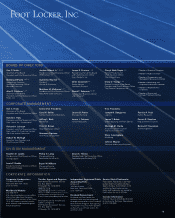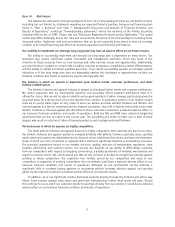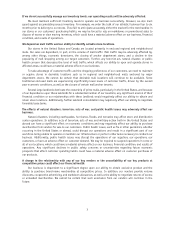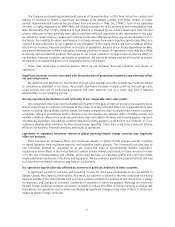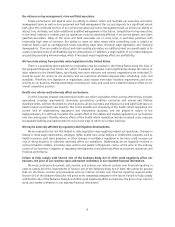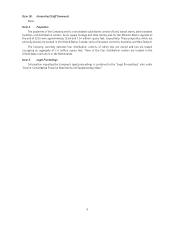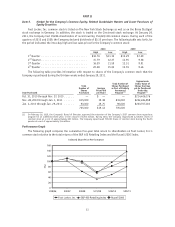Foot Locker 2010 Annual Report Download - page 22
Download and view the complete annual report
Please find page 22 of the 2010 Foot Locker annual report below. You can navigate through the pages in the report by either clicking on the pages listed below, or by using the keyword search tool below to find specific information within the annual report.If we do not successfully manage our inventory levels, our operating results will be adversely affected.
We must maintain sufficient inventory levels to operate our business successfully. However, we also must
guard against accumulating excess inventory. For example, we order the bulk of our athletic footwear four to six
months prior to delivery to our stores. If we fail to anticipate accurately either the market for the merchandise in
our stores or our customers’ purchasing habits, we may be forced to rely on markdowns or promotional sales to
dispose of excess or slow moving inventory, which could have a material adverse effect on our business, financial
condition, and results of operations.
We depend on mall traffic and our ability to identify suitable store locations.
Our stores in the United States and Canada are located primarily in enclosed regional and neighborhood
malls. Our sales are dependent, in part, on the volume of mall traffic. Mall traffic may be adversely affected by,
among other things, economic downturns, the closing of anchor department stores, and a decline in the
popularity of mall shopping among our target customers. Further, any terrorist act, natural disaster, or public
health concern that decreases the level of mall traffic, which affects our ability to open and operate stores in
affected areas, could have a material adverse effect on our business.
To take advantage of customer traffic and the shopping preferences of our customers, we need to maintain
or acquire stores in desirable locations such as in regional and neighborhood malls anchored by major
department stores. We cannot be certain that desirable mall locations will continue to be available. Some
traditional enclosed malls are experiencing significantly lower levels of customer traffic, driven by the overall
poor economic conditions, as well as the closure of certain mall anchor tenants.
Several large landlords dominate the ownership of prime malls, particularly in the United States, and because
of our dependence upon these landlords for a substantial number of our locations, any significant erosion of their
financial condition or our relationships with these landlords would negatively affect our ability to obtain and
retain store locations. Additionally, further landlord consolidation may negatively affect our ability to negotiate
favorable lease terms.
The effects of natural disasters, terrorism, acts of war, and public health issues may adversely affect our
business.
Natural disasters, including earthquakes, hurricanes, floods, and tornados may affect store and distribution
center operations. In addition, acts of terrorism, acts of war, and military action both in the United States and
abroad can have a significant effect on economic conditions and may negatively affect our ability to purchase
merchandise from vendors for sale to our customers. Public health issues, such as flu or other pandemics, whether
occurring in the United States or abroad, could disrupt our operations and result in a significant part of our
workforce being unable to operate or maintain our infrastructure or perform other tasks necessary to conduct our
business. Additionally, public health issues may disrupt the operations of our suppliers, our operations, our
customers, or have an adverse effect on customer demand. We may be required to suspend operations in some or
all of our locations, which could have a material adverse effect on our business, financial condition, and results of
operations. Any significant declines in public safety concerns or uncertainties regarding future economic
prospects that affect customer spending habits could have a material adverse effect on customer purchases of
our products.
A change in the relationship with any of our key vendors or the unavailability of our key products at
competitive prices could affect our financial health.
Our business is dependent to a significant degree upon our ability to obtain exclusive product and the
ability to purchase brand-name merchandise at competitive prices. In addition, our vendors provide volume
discounts, cooperative advertising, and markdown allowances, as well as the ability to negotiate returns of excess
or unneeded merchandise. We cannot be certain that such assistance from our vendors will continue in the
future.
3





